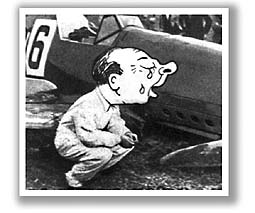


|
During the fourth International Air Meeting held at Zürich-Dübendorf in Switzerland between 23 July and 1 August 1937, the world would get a close-up view of the new Messerschmitt fighter for the first time. A total of five Bf 109s were sent to Dübendorf; three of them equipped with the Jumo 210G engine, with the remainder (Bf 109s V13 and V14) fitted with the Daimler-Benz DB 601 engine. One of the pilots flying the Daimler-Benz powered fighters was none other than the head of the Reichsluftfahrtministerium's technical department, General Ernst Udet, who piloted the V14 (Versuchs; test/prototype No. 14). With its souped-up engine of 1565 hp it took Udet just 23 minutes to arrive at Dübendorf from Augsburg at an average speed of 485 km/h. The assembled crowd at the airport was amazed to see the sleek new aircraft. With its retractable landing gear, enclosed cockpit, fuel-injected engine, and a top speed of 570 kph, it was a sensation and definitely the most modern fighter aircraft in the world. However, although the meeting was a success for the Germans with their Bf 109 winning all competitions, the V14 would crash on 27 July due to problems with the fuel system. With a stalled engine Udet managed to make a forced-landing during which his plane struck a high voltage railway power line as it came down at Schwäbis, near Thun. The plane was a total write-off as the power line cut the V14 in half after the cabin. Udet himself escaped the ordeal with only bruises. Known as a great cartoonist and caricaturist, he later drew himself crouching and crying in front of his broken burgundy red toy. Udet was of course a well know WWI fighter ace and with his 62 confirmed victories, the highest scoring German pilot to survive the conflict. After the war Udet spent the 1920s and early 1930s as a stunt pilot, light aircraft manufacturer, and a well-known playboy. After joining the Nazi party, he became involved in the early development of the Luftwaffe. Following his rise to the post of Director-General of Equipment for the Luftwaffe, the stress of the position, his poor relations with the party, and his distaste for administrative duties caused Udet to turn to drink. Developing alcoholism, he committing suicide on 17 November 1941. Note that this machine was painted the same color as Ernst Udet's Fokker D.VII F fighter while flying in Jasta 35b. |

|
|
|
|
|
|